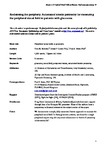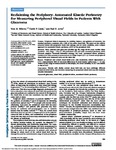Reclaiming the periphery: Automated kinetic perimetry for measuring peripheral visual fields in patients with glaucoma
| dc.contributor.author | Moenter, VM | |
| dc.contributor.author | Crabb, DP | |
| dc.contributor.author | Artes, Paul | |
| dc.date.accessioned | 2017-01-10T15:19:40Z | |
| dc.date.available | 2017-01-10T15:19:40Z | |
| dc.date.issued | 2017-02-01 | |
| dc.identifier.issn | 1552-5783 | |
| dc.identifier.issn | 1552-5783 | |
| dc.identifier.uri | http://hdl.handle.net/10026.1/8227 | |
| dc.description.abstract |
PURPOSE: Peripheral vision is important for mobility, balance, and guidance of attention, but standard perimetry examines only <20% of the entire visual field. We report on the relation between central and peripheral visual field damage, and on retest variability, with a simple approach for automated kinetic perimetry (AKP) of the peripheral field. METHODS: Thirty patients with glaucoma (median age 68, range 59-83 years; median Mean Deviation -8.0, range -16.3-0.1 dB) performed AKP and static automated perimetry (SAP) (German Adaptive Threshold Estimation strategy, 24-2 test). Automated kinetic perimetry consisted of a fully automated measurement of a single isopter (III.1.e). Central and peripheral visual fields were measured twice on the same day. RESULTS: Peripheral and central visual fields were only moderately related (Spearman's ρ, 0.51). Approximately 90% of test-retest differences in mean isopter radius were < ±4 deg. Relative to the range of measurements in this sample, the retest variability of AKP was similar to that of SAP. CONCLUSIONS: Patients with similar central visual field loss can have strikingly different peripheral visual fields, and therefore measuring the peripheral visual field may add clinically valuable information. | |
| dc.format.extent | 868-868 | |
| dc.format.medium | ||
| dc.language | en | |
| dc.language.iso | en | |
| dc.publisher | Association for Research in Vision and Ophthalmology (ARVO) | |
| dc.subject | Aged | |
| dc.subject | Aged, 80 and over | |
| dc.subject | Female | |
| dc.subject | Glaucoma | |
| dc.subject | Humans | |
| dc.subject | Male | |
| dc.subject | Middle Aged | |
| dc.subject | Scotoma | |
| dc.subject | Vision Disorders | |
| dc.subject | Visual Field Tests | |
| dc.subject | Visual Fields | |
| dc.title | Reclaiming the periphery: Automated kinetic perimetry for measuring peripheral visual fields in patients with glaucoma | |
| dc.type | journal-article | |
| dc.type | Journal Article | |
| dc.type | Research Support, Non-U.S. Gov't | |
| plymouth.author-url | https://www.ncbi.nlm.nih.gov/pubmed/28159974 | |
| plymouth.issue | 2 | |
| plymouth.volume | 58 | |
| plymouth.publication-status | Published | |
| plymouth.journal | Investigative Ophthalmology and Visual Science | |
| dc.identifier.doi | 10.1167/iovs.16-19868 | |
| plymouth.organisational-group | /Plymouth | |
| plymouth.organisational-group | /Plymouth/Faculty of Health | |
| plymouth.organisational-group | /Plymouth/Faculty of Health/School of Health Professions | |
| plymouth.organisational-group | /Plymouth/REF 2021 Researchers by UoA | |
| plymouth.organisational-group | /Plymouth/REF 2021 Researchers by UoA/UoA03 Allied Health Professions, Dentistry, Nursing and Pharmacy | |
| plymouth.organisational-group | /Plymouth/Research Groups | |
| plymouth.organisational-group | /Plymouth/Research Groups/Institute of Health and Community | |
| plymouth.organisational-group | /Plymouth/Users by role | |
| plymouth.organisational-group | /Plymouth/Users by role/Academics | |
| dc.publisher.place | United States | |
| dcterms.dateAccepted | 2017-01-04 | |
| dc.identifier.eissn | 1552-5783 | |
| dc.rights.embargoperiod | No embargo | |
| rioxxterms.versionofrecord | 10.1167/iovs.16-19868 | |
| rioxxterms.licenseref.uri | http://www.rioxx.net/licenses/all-rights-reserved | |
| rioxxterms.licenseref.startdate | 2017-02-01 | |
| rioxxterms.type | Journal Article/Review | |
| plymouth.oa-location | http://iovs.arvojournals.org/article.aspx?articleid=2601380 |



